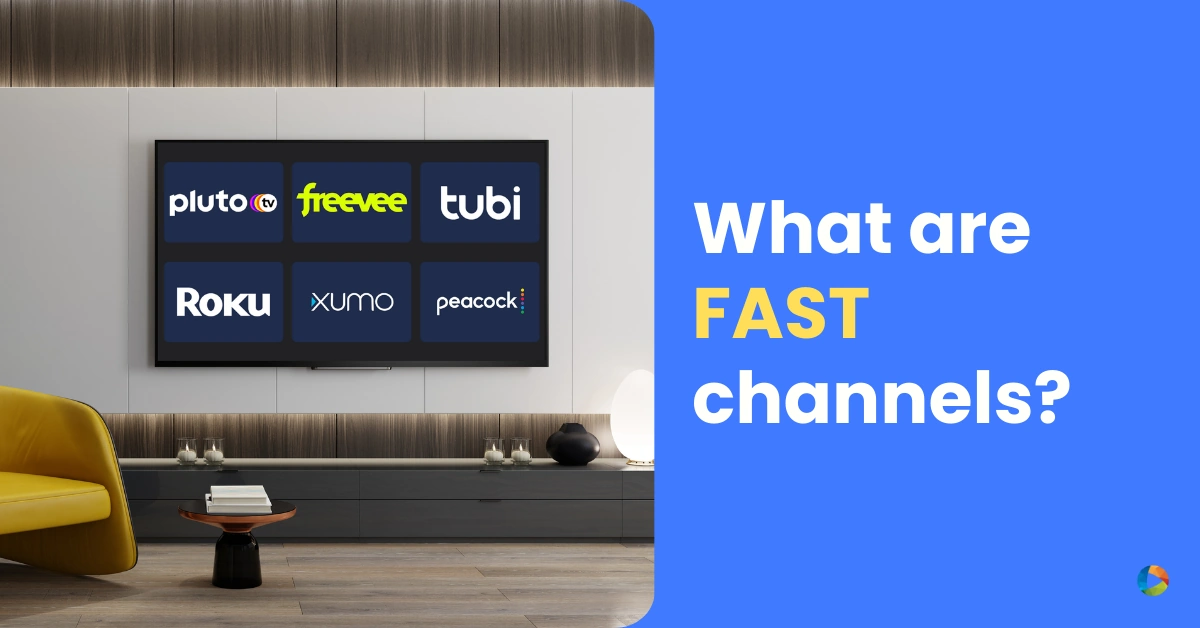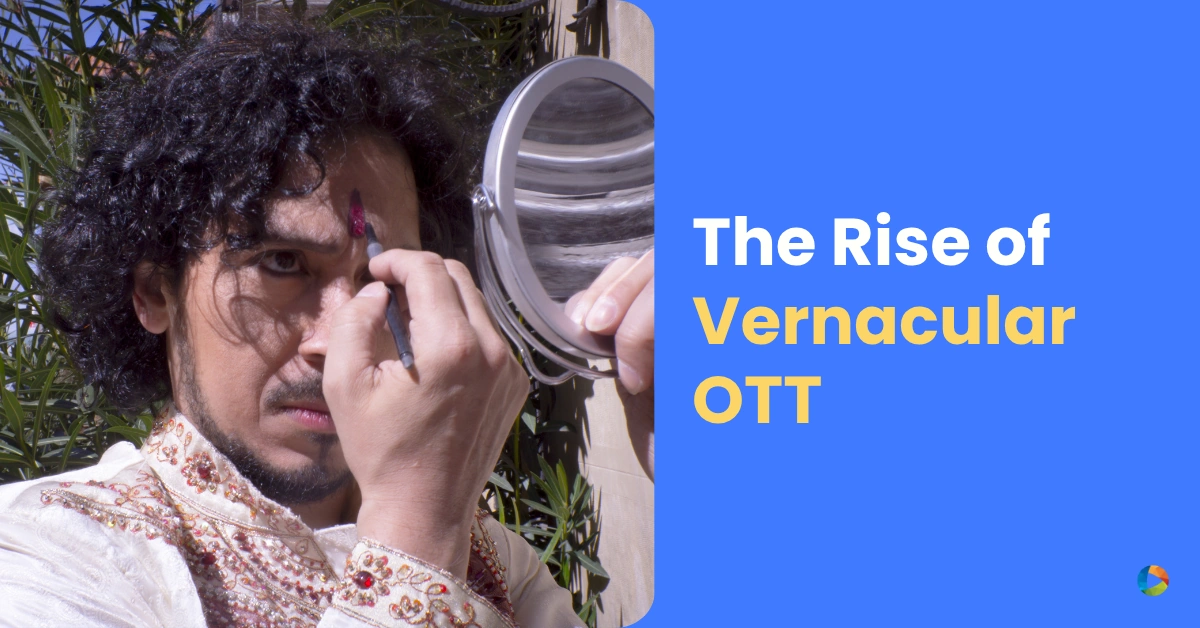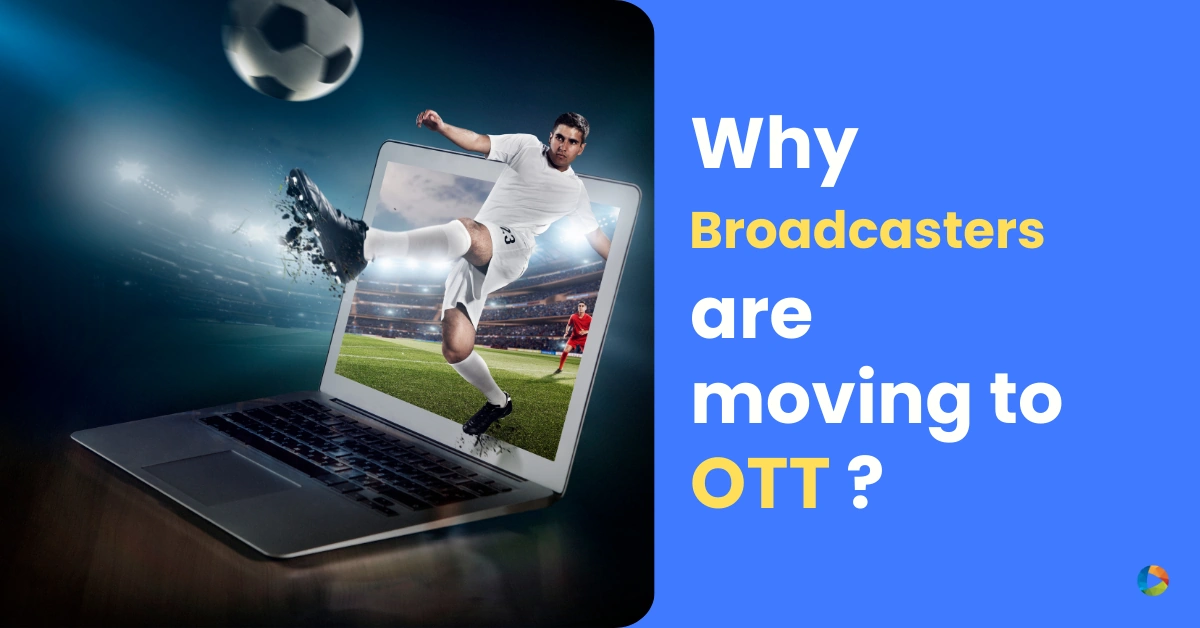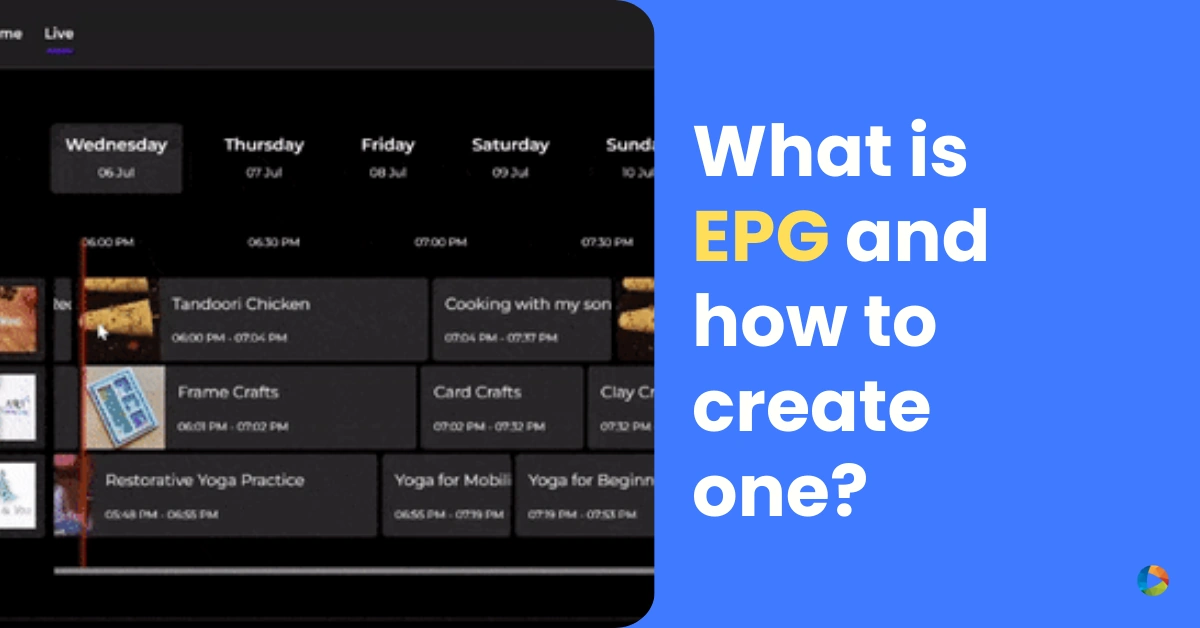What are FAST channels?
Last Updated on May 20, 2025 by Anjana Devi
The FAST TV audience has been on the rise in recent times. Multiple FAST platforms are now bigger in terms of the number of viewers compared to cable and satellite TV platforms in the U.S. This is a turning point for many live TV channels and content publishers as it is going to demand a lot more from them both. FAST Channels are not only at a turning point in terms of content quantity and the rising number of viewers but the revenue as well.
A recent example is Amazon’s pitch to publishers about carrying out linear channels on IMDB TV. Publishers would stand to receive 55% of the net revenue from their IMDb TV channels.
FASTs are services that are free to use, supported by advertisements. FAST TVs provide both linear channel and on-demand programming in a single viewing experience. Some of the biggest names are Samsung TV Plus and The Roku Channel.
The revenue of linear free ad-supported streaming TV (FAST) in the United States is expected to reach 4.1 billion U.S. dollars by 2023.
In this article, we will see why it is a good replacement for linear TV, why audiences and brands are steering towards FAST channels, and how content publishers can make the most out of this opportunity.
What is a FAST channel?
FAST (Free Ad-Supported Streaming TV) channels provide a subscription-free way to watch streaming TV, supported entirely by ads. Instead of requiring a paid subscription, these channels generate revenue through programmatically inserted ads during scheduled ad breaks.
FAST channels bring the traditional linear TV experience to internet-enabled devices such as connected TVs (CTVs), mobile phones, and tablets. Like cable or satellite TV, FAST channels follow a set programming schedule, allowing viewers to tune in and watch content live.
The most popular FASTs are Pluto TV (ViacomCBS), Xumo (NBCU), Tubi (Fox), Peacock (NBCU), The Roku Channel (RokuTM), IMDbTV (Amazon), and Samsung TV+ (Samsung).
FAST channels are of two types: Syndicated or niche channels and Brand channels.
Syndicated or niche channels are published by media and catalog holders with themes like cooking and science-fiction. These are quite similar to thematic channels found on cable and satellite packages.
An example of a niche channel is Peacock – launched by Comcast. All its channels are based entirely on the content from NBCUniversal.
Brand channels are published by companies and brands. These channels offer content related to the products, services, or values of that particular brand or company. They also broadcast premium content.
The best example of branded channels is Pluto TV which showcases over 40 channels of Viacom after being purchased by the brand.
It is vital to understand the difference between FAST and AVOD. The distinction between the two will help us understand the audience better. It will also help content owners and publishers in deciding the genre of content they want to push on their FAST channels.
How is FAST different from AVOD?
AVOD stands for ad-supported video-on-demand. This ad-supported video content is monetized instead of a subscription.
On the other hand, FAST channels are the same. The only difference is that instead of ad-supported on-demand content, it is ad-supported live TV content.
While both AVOD and FAST offer free, ad-supported streaming experiences, they operate under distinct models. Here’s how they compare
1. Content Library
- AVOD: Offers a vast selection of on-demand content, including movies, TV shows, and exclusive programming. Users can choose what to watch and when, allowing for a personalized viewing experience.
- FAST: Delivers a linear TV experience with scheduled programming, similar to traditional cable. Viewers have limited control over what’s playing at any given time.
2. User Experience
- AVOD: Provides interactive features like pause, rewind, fast-forward, and watchlists. Users can curate their own viewing schedules.
- FAST: Functions like traditional TV, offering a continuous stream of scheduled content. Some platforms may include limited on-demand options, but overall, it mimics a channel-surfing experience.
3. Monetization Strategy
- AVOD: Generates revenue through ad-supported video, with advertisers paying for targeted ad placements. Ads are typically inserted before or during on-demand content.
- FAST: Monetizes through ad slots within linear programming, with real-time ad insertions supporting free content access.
4. Content Discovery
- AVOD: Users actively search for and select content based on recommendations and algorithms that tailor suggestions to their preferences.
- FAST: Viewers discover content passively, similar to flipping through TV channels, stumbling upon shows rather than actively searching for them.
5. Ad Insertion & Scalability
- FAST: Designed for live-streaming scenarios, FAST channels use server-side ad insertion (SSAI) to seamlessly integrate ads into live broadcasts. This ensures minimal buffering, reduced ad-blocker interference, and scalability for high-volume live-stream events. However, real-time control over ad placement is limited.
- AVOD: Supports both live and on-demand content, using client-side ad insertion (CSAI) or pre-roll ads. This method provides more control over ad placements within videos, allowing for flexible monetization across various content genres.
So, What’s the Difference Between AVOD and FAST?
So, What’s the Difference Between AVOD and FAST?
AVOD = On-demand viewing. Users choose what to watch, when they want, similar to Youtube.
FAST = Linear streaming. Channels run on a scheduled lineup, like traditional TV, where viewers tune in to what’s currently playing (e.g., Pluto TV’s live channels, Samsung TV Plus).
Key Difference? AVOD = Choose & Watch | FAST = Tune In & Watch
Types of FAST Channel
1. Platform-agnostic FAST channels
These channels are available on multiple platforms, such as smart TVs, streaming devices, and mobile apps. Examples include Pluto TV and Xumo TV.
2. Platform-exclusive FAST channels
These channels are only available on a specific platform, such as Apple TV+ on Apple devices.and Samsung TV plus for Samsung devices.
3. Niche/syndicated FAST channels
These channels focus on a specific genre or topic, such as KweliTV for black community movies or Hayu for reality TV.
4. Branded FAST channels
These channels are created by and associated with a specific brand, such as Red Bull TV from Red Bull.
5. Pure FAST channels
These channels offer a free, ad-supported streaming experience without any premium tiers or subscriptions. Examples include Tubi, Crackle, and Popcornflix.
6. Premium FAST channels
These channels offer a free, ad-supported streaming experience with a premium tier that offers additional features, such as ad-free viewing or early access to new content. Examples include Peacock Premium and Paramount+ Premium.
Why are brands entering the FAST race?
There has been an acceleration of free, ad-supported channels on platforms like The Roku Channel. Roku came up with this platform to provide their customers who wanted more free content on the platform.
This brings us to the investments that are being directed toward video services from Amazon and Roku. Viacom invested a whopping $340 million to acquire Pluto TV, which shows that the race of owning a free streaming service is picking up speed.
Let us take a look at the major reasons why brands are entering the market to own the FAST race.
Maximizing content usage – More impressions
With free content, platforms now have an opportunity to make use of all the idle content in their library. Many channels are providing idle content as free to watch content in order to improve views or impressions on the platform. As a result, ad-supported programming is experiencing a faster growth when it comes to users and overall consumption, as compared to subscriptions.
Exposure – Reaching more audience
As more content is offered to be viewed without any subscription fee, reaching a new audience who are looking for free content and maxed out subscriptions is easier. This gives platforms an opportunity to get exposure in terms of reaching out to more audiences and raising the number of viewers on their platform.
Additional ad revenue
As a result of the free, ad-supported content for visitors on the OTT platform, the revenue from the supporting ads is only going to grow bigger. With more channels, your OTT channel will have more breaks. And with more breaks, there will be more ads to be shown in between. Indeed, a great way to create an ad revenue stream.
Advertisers are said to spend over $25 million on ad-supported TV by 2025, this means more revenue for content owners and publishers.
FAST Channels in 2025: Key Trends Shaping the Future
Whether you’re a marketer or a publisher, the world of CTV is constantly evolving. Staying informed about FAST channels is essential, which is why we’ve highlighted five major trends influencing the future of FAST channels, AVOD, streaming, and CTV as a whole.
1. Content Is Becoming More Accessible
According to Nielsen, only 40% of US streaming time in 2023 was spent on original exclusive programming. Shows which were once exclusive to subscription-based services—are now available on ad-supported platforms. This shift keeps audiences engaged longer, increasing ad exposure and viewership retention.
Nostalgia Drives Engagement
While services like Netflix and Hulu prioritize their original productions, FAST and AVOD platforms serve as a treasure trove of nostalgic content. From vintage sitcoms and classic movies, these platforms cater to audiences seeking familiar favorites.
Ad-Skipping Is Rare
A recent study found that only 93% of FAST viewers do not skip commercials, and 89% appreciate the value it provides. With a receptive audience and precise targeting capabilities, FAST channels offer an ideal environment for advertisers.
A Surge in Niche Channels
FAST services are discovering that there’s an audience for nearly every type of classic content. The ability to quickly curate and launch genre-specific channels means services can easily adapt to changing viewer preferences. For example, The Bob Ross Show is available to binge on at least five different FAST platforms in the US.
Shifting Away from Expensive Subscriptions
Cord-cutters once embraced paid streaming, but now, rising costs are driving them toward free alternatives.
As economic concerns grow, cost-conscious viewers are turning to FAST channels for free, ad-supported content. A Deloitte study found that a $5/month price increase would prompt 55% of Gen Z viewers and 45% of Millennials to cancel their favorite subscription. For these audiences, FAST channels offer a compelling, budget-friendly alternative.
How many users will cancel their favorite paid SVOD service if monthly prices go up by USD 5?

How to launch your FAST channel?
There are two things you must look into at the time of launching your FAST service: content quantity and scheduling.
Content Quantity – At the time of launch, your FAST channel must offer 100-250 hours of content. This must be updated to 10-20 hours of content every month. A large quantity helps you rotate the content and provide your viewers with something new every time they visit your channel.
Scheduling – A FAST platform can schedule programming in two ways: looped playlists and scheduled.
- A looped playlist is simply a playlist of on-demand videos in a loop. Looped playlists do not have the look and feel of a traditional TV channel.
- On the other hand, scheduled playlists are more involved in improving viewer engagement habits by providing them with new content according to a particular schedule.
Here are the three major aspects you must consider before launching your FAST channel.
Content
If you want to succeed in European markets, you must start by localizing your content in native languages. Don’t be limited to using subtitles for the programs, but go ahead and consider dubbing to a local European language.
Many successful FAST TVs like Pluto are successful because they were able to localize their content in different countries.
Also, consider offering more local content. Local news and programs that your target audience will like to watch are also good content options.
Technology
The quality of EPG data must be exceptional. Since FAST is still a linear model of TV watching, the strategy that is followed here must be the same as the linear TV model.
The best way to do this is by controlling your output yourself. Control your content in such a way that users can easily discover your content, whether it is on your own channel or a third-party site.
Ensure that all the EPG data that is translated into the local language is easily findable.
Advertising
Advertising and marketing help you stay several steps ahead of the competition. With advertising, you can make sure potential customers are kept informed of your channel through SEO, proactive distribution of schedules, advertising and more.
Both conventional and digital ads must be utilized to promote FAST channels.
Make sure you are adjusting your marketing and advertising strategy according to the market. The same ad approach for every country will not work out for your FAST channel. You need to understand how users in different countries consume content and ads.
For example, Europeans must be offered an ad structure with fewer breaks to reel them in, this is different from how ads are shown in the United States.
Why Should Your Streaming Service Have a FAST Channel?
Your streaming service should have a FAST channel because it can bring a lot of benefits to streaming platforms of all sizes and types. By carefully assessing your unique needs and objectives, you can formulate a FAST channel strategy tailored to help you accomplish your business goals.
For instance if you are a Small Streaming Service a FAST channel can help you with
1. Increasing Brand Visibility and Discovery
FAST channels offer smaller streaming services an opportunity to boost brand awareness and discoverability, reaching a broader audience.
2. Competitive Advantage
Smaller streaming platforms can leverage FAST channels to compete effectively against larger, established rivals. These channels provide viewers with a free and convenient means of accessing their content, giving them a competitive edge.
If you are a New Streaming Service, you can use FAST channel to
3. Affordable Market Entry
For emerging streaming services, FAST channels are a great way to acquire new customers. Instead of spending heavily on marketing campaigns, you can launch a FAST channel that will help you acquire users at the same time earn with ads.
4. Improving User Engagement
FAST channels empower newer streaming platforms to enhance user engagement by offering viewers a free and convenient avenue to enjoy their content.
If you have a Subscription-Based Streaming Service, your FAST channel can help you with
5. Expanded Subscriber Acquisition and Retention
Subscription-based services can utilize FAST channels as a means to acquire and retain subscribers. These channels can promote subscriptions and encourage viewers to sign up.
6. Improving Customer Satisfaction
FAST channels can be used to provide added value to subscribers, ultimately enhancing their overall satisfaction with the service.
5 Essential Steps to Launch a FAST Channel for Content Owners
Are you a content owner wondering if launching a FAST channel is worth it or feeling overwhelmed by the process? The good news is that it’s easier than you think. Follow these five key steps to launch your FAST channel successfully.
1. Develop a Strong Content Strategy
Decide on the type of content your channel will offer—movies, sports, documentaries, or niche programming. Ensure it aligns with your target audience’s preferences and maintain a steady content pipeline to support 24/7 programming.
2. Secure Content Rights & Licensing
Confirm that you have the proper rights to stream your content, whether through ownership, licensing agreements, or partnerships. Negotiate ad-supported distribution rights and consider repurposing older or niche content to attract specific audiences.
3. Choose the Right Technology Platform
Select a reliable playout and streaming solution, such as Ventuno, to manage content delivery and ad insertion. Use Dynamic Ad Insertion (DAI) to maximize ad revenue and collaborate with other FAST platforms to expand your reach.
4. Define Your Monetization Strategy
Diversify revenue streams with a mix of programmatic and direct ad sales. Implement personalized, non-skippable ads using DAI and explore sponsorships or branded content partnerships to enhance monetization.
5. Test, Launch & Optimize
Conduct thorough testing to ensure smooth playback, high video quality, and effective ad performance across all devices. Promote your channel through platform features and social media campaigns. After launch, track analytics, adjust content schedules, and refine ad strategies for continuous growth.
By following these steps, you can efficiently launch and scale a FAST channel that engages audiences and drives revenue.
How Ventuno Can Help Your FAST Journey
Ventuno provides a comprehensive solution for launching and managing FAST channels, ensuring seamless content delivery, monetization, and audience engagement.
Live and VOD Support
Effortlessly convert your on-demand content to create a dynamic FAST channel experience that keeps viewers engaged.
Intuitive Scheduler
Plan and manage your programming lineup with an easy-to-use scheduler – (more on this in the next section), simplifying content organization and playback.
Auto-Generated EPG
Streamline scheduling with an automatically generated Electronic Program Guide (EPG) for efficient daily, monthly, or long-term programming.
HLS Output
Deliver smooth and high-quality streaming across all devices with HLS (HTTP Live Streaming) output, ensuring a flawless viewing experience
Setting Up Your Cloud Playout Channel
Adding program. The first step for Creating a VOD to Live is to add the VOD content as a program so that it can be converted into an HLS link.
To add program,
- From the EPG section of the left menu select Manage EPG → Create EPG (Custom).
- Select the domain or leave it as it is if you have only one domain.
- Select the Channel under which you want to create a VOD to Live. For example, I have selected the channel Drama Live
- Under ‘Program Type’ you have 3 options to choose from the dropdown list such as ‘Media’, ‘Advertisement’, ‘Promo’.
- If you select ‘Media’, select the ‘Show’ mapped under the channel selected above.
- Once the show is selected, All the videos in the show will be listed in the dropdown under the Videos section. Select the video you want to add as a program.
- Enter the ‘Program Name’. Here you can use the video name as program name or you can use a different name as well.

- Under Program date you can add multiple dates if required by clicking the + icon next to the calendar. (Eg: Series played every day throughout the week).
- Select Program Start Time.
- The ‘Program End Time’ will be automatically assigned based on the duration of the content You selected.
- Click ‘Submit’ to add the program.

EPG- Electronic Programme Guide is used to schedule videos under the channel for your VOD content. To create an EPG,
- From the Cloud Playout section select Program Scheduler → EPG →Create EPG.
- Enter the ‘EPG Name’. Select the ‘Channel’ for the EPG.

- Under ‘Manage EPG’ You have various options such as ‘Edit’, ‘Delete’, ‘Add/Manage program’.
- Once you press the submit button, the EPG URL for the selected channel will be generated and displayed on your screen.

Ad marker is used to ‘Create ad-breaks with your commercials in the live stream’. To create an Ad marker,
- From the left menu under Video playout select Manage EPG(VOD to Live) →Ad → Add Admarker → Enter Marker Name.
- You have two options available while selecting Hosting for the Ad.
- If you select ‘Internal’, you have to select the Ad file from the system storage.
- Select the video file and click ‘Upload’. You need to upload the Ad in mp4 format. Once the Ad is uploaded, it will be converted into an HLS stream and will be inserted into the Stream where you have inserted the ad.

- If you select ‘External’ you have to mention the duration of the ad in seconds and add the M3U8 URL for the ads.
- Click ‘Submit’ to complete adding the Admarker.
- Under ‘Manage Admarkers’ you can delete or preview the ad you have created.

Content fallback is used to fill the gaps in the Livestream where you can’t able to play advertisements or the advertisement or the content failed to play. You can play a Fallback video by using this option in case there is an issue with the live stream.
- From the left menu under Video playout select Manage EPG(VOD to Live) → Fallback → Add content Fallback.
- Enter ‘Fallback Name’.
- You have two options available while selecting ‘Hosting’.
- If you select ‘Internal’, you have to select the video file from the system storage.

- If you select ‘External’ you have to mention the duration of the video in seconds and also enter the ‘M3U8 URL’.
- Click ‘Submit’ to complete the process.

- You can generate the ‘Live Stream URL’ by entering the details of the EPG created.
- Click ‘Generate URL’ to generate your Live Stream URL.
- Once the URL is generated, you can preview this by selecting the Preview button.

- After the M3U8 URL is generated, you need to upload this as a Livestream so that the video will play on the endpoints.

You can view your EPG feed under the ‘EPG Feed’. If you open the URL in a new tab, You can see the list of programs you have added to your VOD to Live stream.

FAQ
FAST stands for “Free Ad-supported Streaming Television.” It refers to streaming platforms that offer free content to viewers supported by advertisements
FAST channels generate revenue through advertising. Advertisers are willing to pay to reach the large and engaged audiences that FAST channels attract.
FAST (Free Ad-supported Streaming Television) benefits streaming services by expanding their reach and offering a cost-effective entry point for new platforms. It also boosts user engagement and supports subscriber acquisition for subscription-based services.
FAST channels offer a number of benefits to viewers, including:
1. Free access to a wide variety of streaming content
2. Convenience and flexibility
3. No subscription required
Popular FAST channels include:
Pluto TV
Roku Channel
Xumo TV
Crackle
Tubi
Peacock Free
Paramount+ Free
IMDb TV
Freevee
Plex
STIRR
DistroTV
FAST channels are available on a variety of devices, including smart TVs, streaming devices, and mobile apps. You can also watch FAST channels on the web.
The FAST industry is growing rapidly, and experts predict that it will continue to grow in the coming years. FAST channels are becoming increasingly popular with viewers, and streaming services are investing heavily in FAST.
Conclusion
FAST channels have transitioned from an early stage of growth and matured. The market has grown exponentially with the entry of some of the biggest platforms in entertainment.
Ad buyers are fascinated with the FAST model as it allows them to run well-targeted non-skippable ads on large screen TVs to millions of users.
So this means that while there are competitors in the market, you have a chance at acquiring a major market share in terms of users. With the growing set of viewers, you will have more channels and more content. What will follow is a growing number of ads which will translate into more revenue for your platform.
Ventuno’s sophisticated technology can help you create the right base for your free, ad-supported streaming.
- Create TV channels from your existing VOD content.
- Monetize your OTT channels with ads, subscriptions, and transactions.
- Cut 24/7 live streams to individual videos and publish these videos across all your apps. Save several hours of manual work.
- Add a paywall to your live stream by integrating your payment gateway with Ventuno. Get paid directly by your users and keep all of your revenue.
- Ventuno Analytics presents data on video engagement, revenue, purchases, users, watch time and much more
If you are a content owner or content distributor launching your FAST channel, Ventuno can help you. Ventuno is the ideal solution to create FAST channels, monetize them, and broadcast them on your own platform. Get in touch with us.
Looking to launch your streaming app?













